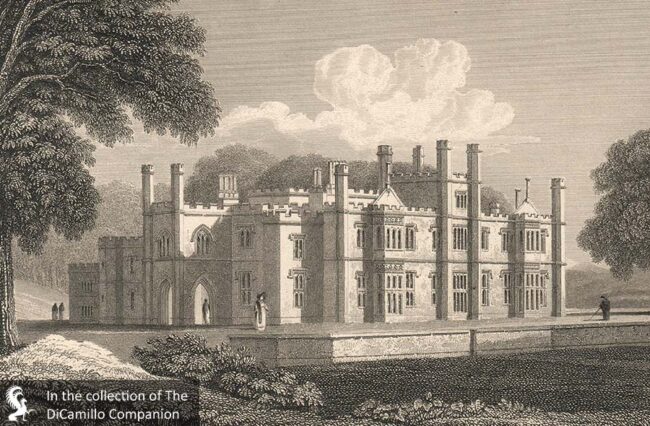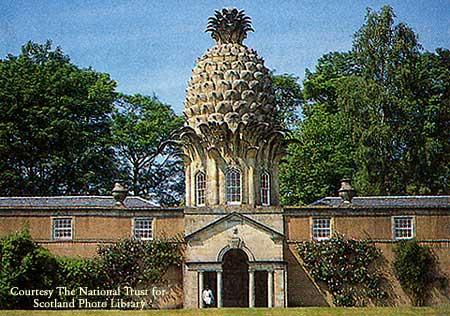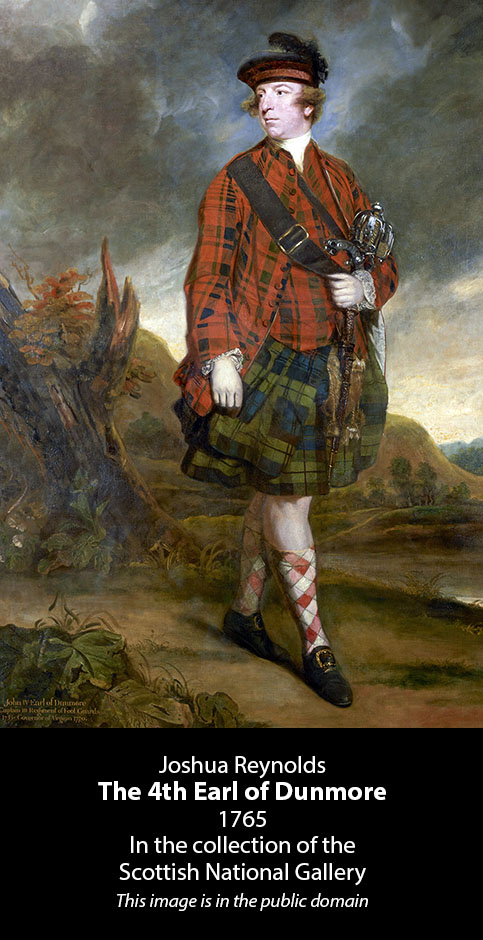
The house from an 1831 engraving

The pineapple folly

Earlier Houses: The 19th century house replaced an earlier house 16th century house, Elphinstone Castle (aka Elphinstone Tower and Dunmore Tower), which was purchased by John Murray, 4th Earl of Dunmore, in 1754 from the Elphinstone family for £16,000 (approximately £30 million in 2019 values using the labour value commodity index). The vaulted basement of the tower of Elphinstone Castle was converted into a mausoleum for the Murray family in the early 19th century, after the family abandoned Elphinstone for the newly-built Dunmore Park. Elphinstone Castle is today little more than a ruinous basement.
Built / Designed For: 5th Earl of Dunmore
House & Family History: The man who built the famous pineapple, the 4th Earl of Dunmore (see “Images” section), was controversial, even in his own time. Apparently not possessed of great intelligence or integrity, Lord Dunmore was, however, opportunistic and self-serving. He was named governor of the Province of New York in 1770 and appointed governor of Virginia in 1771, where he directed a series of military campaigns against the Native Americans that came be to be known as Lord Dunmore's War. He is most remembered today for his 1775 document, Dunmore's Proclamation, that offered freedom to any slave who fought for the British Crown against the American rebels in the nascent revolution. Slightly altruistic sounding on the surface, Lord Dunmore’s Proclamation was actually the move of a desperate man who strongly believed in the institution of slavery (he owned 56 slaves himself), but who needed to buy time until troop reinforcements arrived. The news of his offer of freedom spread rapidly in the South and, much to Lord Dunmore’s surprise, caused conservative, loyalist Southerners (who wanted to retain slavery and were horrified by the prospect of the mass freeing of slaves) to ally themselves with the passionate, rebel Northerners, whom they had earlier treated with suspicion. Thus, Dunmore helped create a unified colonial response that became the American War for Independence—a war that was just as focused on keeping slavery intact in North America as it was on gaining independence from Great Britain. So alarmed was George Washington at the prospect of millions of freed slaves that, in 1775, he declared of Lord Dunmore, “If that man is not crushed before spring, he will become the most formidable enemy America has…” Dunmore escaped to New York after the burning of Norfolk in 1776, from whence he returned to Britain. The last royal colonial governor of Virginia, he also served as governor of the Bahamas from 1787 until 1796. The Tudor-Gothic Dunmore Park was built in the early 19th century by the 4th Earl's eldest son, George Murray, 5th Earl of Dunmore. Though the Murray family decamped in 1911, the house remained a private home until 1961. It served as a girls' boarding school until 1964, after which it was abandoned. The house, together with the rest of the Dunmore Estate, was auctioned in 1970; parts of the house were demolished in 1972 and the remainder left as a decaying ruin.
Garden & Outbuildings: There are several extant outbuildings on the Dunmore Estate, including the castellated 1820s stableblock, the early 19th century castellated east lodge (on the B9214), and the Elizabethan style parsonage, the later a large double house by David Bryce that was originally built (1845-46) to house the estate’s chaplain and factor. The most noted building at Dunmore, however, is the Grade A-listed world-famous pineapple (see "Images" section), considered one of the greatest follies in the United Kingdom. In 1761 the 4th Earl of Dunmore added a huge stone pineapple crown to an existing outbuilding on his estate (then called Elphinstone). Beyond the fact that the pineapple was a symbol of hospitality, why the earl chose this exotic fruit to top this building has remained a mystery. The most accepted theory is that it was created as a birthday gift for his wife, Charlotte, to enable her to view the large walled garden. For centuries it has been assumed that the 45-foot-high ashlar fruit was created by imported Italian stonemasons because the standard of craftsmanship is so high, but this remains speculation. What is known is that, by 1973, the pineapple was derelict. It was saved by the Landmark Trust, who leased the folly that year from the National Trust for Scotland, restored the building, and opened it as holiday accommodation in 1975, a use it continues to serve today. The Dunmore Estate was broken up and sold in lots in 1970. At that sale Nancy, Countess of Perth, purchased the lot that comprised the pineapple, the walled garden, a lake, and 16 acres of woodland, all of which she donated to the National Trust for Scotland in 1973. The 16 acres of gardens and woodland are open to the public by the NTS year-round.
Chapel & Church: The early 19th century St. Andrew's Church (Anglican), built near the ruins of Elphinstone Castle, was demolished, probably in the late 20th century.
Architect: William Wilkins Jr.
Date: 1820-25John Preston (J.P.) Neale, published under the title of Views of the Seats of Noblemen and Gentlemen in England, Wales, Scotland, and Ireland, among other titles: 2.S. Vol. III, 1826. Scotland, 1830.
Title: Buildings of Scotland: Stirling and Central Scotland, The
Author: Gifford, John; Walker, Frank Arneil
Year Published: 2002
Reference: pgs. 452-454
Publisher: New Haven: Yale University Press
ISBN: 0300095945
Book Type: Hardback
House Listed: Category B
Park Listed: Listed as a Garden & Designed Landscape
Past Seat / Home of: SEATED AT EARLIER HOUSE: Elphinstone family, until 1754. John Murray, 4th Earl of Dunmore, 1754-1809; George Murray, 5th Earl of Dunmore, 1809-23. SEATED AT CURRENT HOUSE: George Murray, 5th Earl of Dunmore, 1823-36; Alexander Edward Murray, 6th Earl of Dunmore, 1836-45; Charles Adolphus Murray, 7th Earl of Dunmore, 1845-1907; Murray family here from 1754 until 1911.
Current Ownership Type: The National Trust for Scotland
Primary Current Ownership Use: Mixed Use
Ownership Details: The house is a ruin. The grounds are open to the public (free) by the National Trust for Scotland. The pineapple folly is let as holiday accommodation by the Landmark Trust.
House Open to Public: Grounds Only
Phone: 01324-831-137
Email: [email protected]
Website: https://www.nts.org.uk/
Historic Houses Member: No